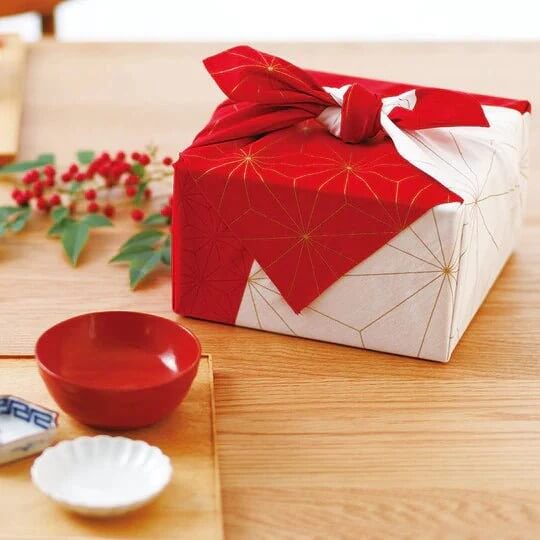Furoshiki, the Japanese art of cloth wrapping, has been a beloved tradition for over a thousand years. Not only does it possess deep cultural significance, but it's also an eco-friendly approach to packaging gifts, transporting items, and even fashioning apparel. This ancient practice is experiencing a resurgence globally, as more people discover the beauty and practicality of Furoshiki. Mastering the art of Furoshiki knotting can add a touch of elegance to your wrapping repertoire. Let’s unwrap the mystery of Furoshiki and learn how to create beautiful knots that carry profound meaning.
The Basic Knot for Furoshiki
The foundation of Furoshiki is the simple basic knot, called the 'Ma-musubi' (or 'Hon-Musubi') in Japanese.
Ma-Musubi is the traditional method of tying a furoshiki, which has been practiced in Japan since ancient times. This knotting technique involves aligning the knots parallel to the body, creating a uniform and streamlined appearance.
This knot holds great significance, as it symbolizes a strong and enduring bond. Due to its secure nature, Ma-Musubi is not easily undone, adding to its auspicious nature.
It is also said to be auspicious because the lower part of the knot widens and opens toward the edge, which means "the end spreading out" or "Fuji (shaped like Mt. Fuji) object which means the one and only (Fuji-no-Mono) object.
The Ma-Musubi knot, while viewed differently in Japan, is also recognized as a fundamental knot in foreign countries. It is known for its ability to remain secure without unraveling. One example where this knot is commonly used is in men's bow ties.
During festive occasions in Japan, furoshiki is traditionally adorned with a beautiful Ma-Musubi knot..
Traditional Furoshiki [ Leaf and Tortoiseshell ] 70 x 70cm
The Incorrect Knot for Furoshiki
However, the vertical knot, unlike Ma-Musubi, is not as strong and tends to unravel easily, making it unsuitable for practical purposes.
The vertical knot, where the knot intersects the body at a right angle, is a knot that should not be tied in the traditional Japanese way.
In traditional Japanese funerals, the Obi (Kimono Sash) of the deceased person's kimono is tied vertically as a symbolic gesture to counteract the normal way and remove any impurities. This specific knot is considered inappropriate for everyday use, let alone when wrapping something of significance, due to its association with funerals.
How to knot Ma-Musubi with Furoshiki

Image from Yamada sen-i/ Musubi
- 1: Hold each end.
- 2: Cross the two ends with the red one behind.
- 3: Bring the red one forward so that it wraps around the green one, then pass under the green one and bring it back.
- 4: Tilt the green side to the left and place the red side on top of the green side.
- 5: Pass the red one through the loop created by the green one.
Different Furoshiki Knotting Techniques
Moving beyond the basic knot, Furoshiki offers a myriad of techniques, each suited for different objects and occasions. Here are a few popular knots:
Otsukai Tsutsumi
Ideal for wrapping books or boxes; involves folding the fabric into a neat rectangular package with tucked-in ends. This is one of the most typical and traditional ways of wrapping Furoshiki.
Otsukai refers to running errands, while Tsutsumi means to wrap or package something.
Bin Tsutsumi (Bottle Wrapping)
Designed for bottles; creates a handle at the top, making the item easy to carry.
Bin means Bottle.
Suika Tsutsumi (Watermelon Wrapping)
Perfect for wrapping round objects like melons; results in a petal-like design at the top.

Image from Yamada sen-i/ Musubi
A shoulder bag knot that adapts to larger items or shopping needs.
Furoshiki of 70~100 cm square are easy to make shopping bags.
Best Materials for Furoshiki Wrapping
While the technique is important, the material of your Furoshiki also plays a crucial role. Traditional Furoshiki are made of silk, cotton, rayon, or nylon, chosen for their durability and ease of knotting.
-
Silk
Luxurious and ideal for special gifts. -
Cotton
Sturdy and versatile, suitable for everyday use.
Our furoshiki collection features exquisite organic cotton furoshiki with a soft and luxurious texture. -
Polyester
Durable and water-resistant, making it great for carrying items outdoors.
Our collection of furoshiki also offers a diverse range of polyester furoshiki, featuring a water-repellent finish for added convenience and durability.
Choosing the right fabric ensures that your Furoshiki is not just functional but also a pleasure to use.
Begin your Furoshiki journey
Furoshiki knotting is more than a craft—it's a sustainable choice and an expression of care that enriches our gifting experiences. From simple knots to intricate wrappings, Furoshiki allows you to infuse tradition and sustainability into your daily life.
Visit our Furoshiki Collection page to find a variety of Furoshiki cloths, each with the promise of quality and authenticity. Whether you are wrapping a keepsake for a loved one or packaging a mundane object, the elegance of Furoshiki will transform the mundane into something magical.
Take a look at this article to learn more about the Furoshiki culture.
Our picks for new Furoshiki users









